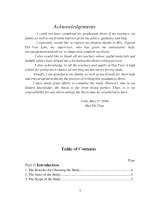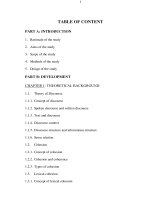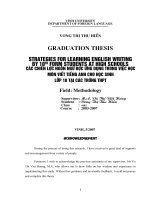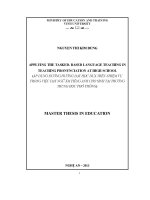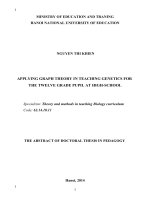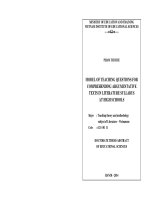DSpace at VNU: Applied Research Cybered software in teaching natural science subjects at high school
Bạn đang xem bản rút gọn của tài liệu. Xem và tải ngay bản đầy đủ của tài liệu tại đây (158.87 KB, 7 trang )
Vietnam National University, Hanoi
PROJECT PROPOSAL SUMMARY
1. Project Title: Applied Research Cybered software in teaching natural science subjects
at high school (for students of the Faculty of Education, VNU, Hanoi).
2. Code Number: QS.08.01
3. Project Leader: Pham Van Tien
4. Directing Institution: College of Education
5. Cooperating Institution(s):
6. Field of Research: Applying information technology in teaching-learning
7. Duration (number of years): 2 years, from December 31, 2007 to December 31, 2009.
8. Project’s Goals: Exploitation and development of application software Cybered
teaching natural science subjects of mass pedagogical knowledge in the Department of
Teacher of Education college, VNU.
9. Abstract: The main contents of the project is that Research processes and technique to
exploit cybered software in teaching the subjects Physics, Chemistry, Biology at
secondary school. And building the electronic lectures based on SCORM standard by
using cybered software products. Furthermore, Vietnamese localization of the terms
cybered software to facilitate the users to exploit. In addition, deployment of the software
application has been exploited for students of grade QH-2006-S. Lastly, evaluation the
effectiveness of the exploitation and use of cybered software in improving the quality of
teaching mastery of knowledge and develop exciting, creative, promote positive selfsolving problem students in the learning process.
In this project, we have used two main methods for research such as theoretical, empirical
research.
10. Expected Results
+ New Scientific Contributions: Open a new direction in teaching-learning, Promote the
application of information technology in teaching.
+ Possible Application: Applying in teaching natural science subjects such as Physics,
Chemistry and Biology.
+ Contribution to Training: Guide for students doing dissertations, research.
11. Funding
+ Total Funding: 30,000,000.00 VND
+ Sources of Funding: VNU
+ From VNU: all of fund from VNU
+ From other Sources: No
+ Planned Budget: 15,000,000.00 VND for the first year, and 15,000,000.00 for the last.
12. Possible International Cooperation: Utilizing the research results of the world to
reinforce the project's.
13. Special Suggestions: Need additional funding to develop the project well.
Signature
BIỂU MẪU 14/KHCN/ĐHQGHN
(Kèm theo hướng dẫn số ……/KHCN ngày ……/……./2007
của Giám đốc ĐHQGHN)
PHIẾU ĐĂNG KÝ
KẾT QUẢ NGHIÊN CỨU CÁC ĐỀ TÀI KHCN CẤP ĐHQGHN
Tên đề tài: Nghiên cứu ứng dụng phần mềm Cybered trong dạy học các ôn khoa học tự
nhiên bậc Trung học phổ thông (cho sinh viên trường Đại học Giáo dục – ĐHQGHN).
Mã số: QS.08.01
Cơ quan quản lý đề tài:
Đại học Quốc gia Hà Nội
Địa chỉ:
144, đường Xuân Thuỷ, Cầu Giấy, Hà Nội
Điện thoại:
7548664
Cơ quan chủ trì đề tài: trường Đại học Giáo dục - ĐHQGHN
Tổng chi phí thực thi: 30,000,000.00 VNĐ
Trong đó: - Từ ngân sách Nhà nước: 30,000,000.00 VNĐ
Nguồn khác:
không có
Thời gian nghiên cứu: 2 năm
Thời gian bắt đầu: 31/12/2007
Thời gian kết thúc: 31/12/2009
Tên các cán bộ phối hợp nghiên cứu:
- Chủ trì đề tài: ThS. Phạm Văn Tiến
- Những người tham gia: - PGS.TS. Lê Kim Long
- TS. Nguyễn Thế Hưng
- ThS. Phạm Kim Chung
Số đăng ký đề tài
Số chứng nhận đăng ký KQNC
Bảo mật
A. Phổ biến rộng rãi
B. Phổ biến hạn chế
Ngày
Ngày
C. Bảo mật
Tóm tắt kết quả nghiên cứu: Qua quá trình nghiên cứu, chúng tôi đã hoàn thiện việc biên
dịch toàn bộ các sản phẩm của phần mềm Cybered và sử dụng các sản phẩm này trong
việc xây dựng các bài giảng điện tử với các kỹ thuật đạt tiêu chuẩn của Đại học Quốc gia
Hà Nội và các tiêu chuẩn quốc tế về Elearing.
Với quy trình trên chúng tôi đã xây dựng bài giảng cho các môn học: Hoá học, Vật lý và
Sinh học.
* Đối với môn Hoá học (với 20 đĩa CD), chúng tôi đã tổ chức lại và xây dựng thành 35
video thí nghiệm, 125 file flash thí nghiệm ảo, và nhiều bài toán trắc nghiệm kiến thức
hoá học Trung học phổ thông.
* Đối với môn Vật lý (với 15 đĩa CD), chúng tôi đã tổ chức lại và xây dựng thành 17
video thí nghiệm, 80 file flash thí nghiệm ảo, và nhiều bài toán trắc nghiệm kiến thức vật
lý Trung học phổ thông.
* Đối với môn Sinh học (với 10 đĩa CD), chúng tôi đã tổ chức lại và xây dựng thành 21
video thí nghiệm, 54 file flash thí nghiệm ảo, và nhiều bài toán trắc nghiệm kiến thức sinh
học Trung học phổ thông.
Hệ thống các bài giảng này chúng tôi đã triển khai thử nghiệm cho 3 lớp sư phạm Vật lý,
Hoá học và Sinh học K51 của trường Đại học Giáo dục.
Ngoài ra, vận dụng quy trình trên chúng tôi đã xây dựng 2 bài giảng điện tử Phương pháp
dạy học Vật lí, Phương pháp dạy học Hóa học theo dự án của Đại học Quốc gia Hà Nội.
Hai bài giảng trên đã được Đại học Quốc gia Hà Nội nghiệm thu và đánh giá tốt.
Hướng tới đào tạo trực tuyến và triển khai thử nghiệm tích hợp bài giảng điện tử trên hệ
LMS, chúng tôi đã cài đặt hệ Moodle lên mạng LAN của trường Đại học Giáo dục và thử
nghiệm đưa bài giảng điện tử lên mạng.
Về mặt kỹ thuật cho thấy hệ này đang chạy ổn định trên mạng LAN của trường Đại học
Giáo dục và các bài giảng điện tử đưa lên hoàn toàn tương thích và chạy tốt.
Do hạn chế về cơ sở hạ tầng kỹ thuật mạng, chúng tôi chỉ có thể thử nghiệm Bài giảng
điện tử trên 2 mô hình: chạy Offline trên CD và chạy online trên mạng LAN. Đây cũng là
hạn chế của đề tài, để có thế triển khai trên mạng Internet, đề tài còn cần nghiên cứu mở
rộng hơn nữa.
Kiến nghị về quy mô và đối tượng áp dụng kết quả nghiên cứu:
- Để tăng cường hiệu quả của quá trình tổ chức dạy học với sự hỗ trợ của Giáo trình điện
tử, Bài giảng điện tử cần được tổ chức thực hiện một cách có hệ thống, đối với tất cả các
môn học của trường Đại học Giáo dục để tạo cho sinh viên một thói quen làm việc tích
cực, tự giác và chủ động.
- Tăng cường trang thiết bị (đặc biệt là hệ thống máy chủ) một cách đồng bộ để có điều
kiện sử dụng theo phương pháp dạy học tích cực. Đồng thời có biện pháp tích cực khuyến
khích giảng viên xây dựng và ứng dụng Bài giảng điện tử trong dạy học.
Trong quá trình thực hiện đề tài, chúng tôi nhận thấy: Đây là một đề tài mới, có ý nghĩa
thực tiễn về vận dụng lý luận dạy học vào xây dựng những Bài giảng điện tử dạy học nói
chung và dạy học các môn thuộc khối nghiệp vụ sư phạm nói riêng. Chính vì vậy đề tài
cần được bổ sung, mở rộng hơn nữa.
Qua đề tài này, chúng tôi cũng rất mong được sự quan tâm của các thầy cô giáo, các nhà
sư phạm, các chuyên gia CNTT, các giảng viên và học viên góp ý kiến cho đề tài của
chúng tôi hoàn thiện hơn nữa, tạo điều kiện cho chúng tôi mở rộng sang phần nội dung
khác trong chương trình đào tạo của trường Đại học Giáo dục, góp phần nâng cao chất
lượng dạy học các môn nghiệp vụ sư phạm.
Chức vụ
Chủ nhiệm đề Thủ trưởng cơ quan Chủ tịch hội Thủ trưởng cơ quan
tài
chủ trì đề tài
đồng đánh giá quản lý đề tài
chính thức
Họ và tên
Phạm Văn
Tiến
Thạc sỹ
Học vị
Ký tên
Đóng dấu
BÁO CÁO TÓM TẮT KẾT QUẢ THỰC HIỆN ĐỀ TÀI KHCN CỦA ĐHQGHN BẰNG
TIẾNG ANH
SUMMARY
Project Title: Applied Research Cybered software in teaching natural science subjects at
high school (for students of the Faculty of Education, VNU, Hanoi).
Code number: QS.08.01
Coordinator: Pham Van Tien
Implementing Institution: College of Education
Cooperating Institution (s):
Duration: from December 31, 2007 to December 31, 2009.
1. Objectives: Exploitation and development of application software Cybered teaching
natural science subjects of mass pedagogical knowledge in the Department of Teacher of
Education college, VNU.
2. Main contents: The main contents of the project is that Research processes and
technique to exploit cybered software in teaching the subjects Physics, Chemistry,
Biology at secondary school. And building the electronic lectures based on SCORM
standard by using cybered software products. Furthermore, Vietnamese localization of the
terms cybered software to facilitate the users to exploit. In addition, deployment of the
software application has been exploited for students of grade QH-2006-S. Lastly,
evaluation the effectiveness of the exploitation and use of cybered software in improving
the quality of teaching mastery of knowledge and develop exciting, creative, promote
positive self-solving problem students in the learning process.
3. Results obtained: Through the research process, we have completed the entire
translation of software products Cybered and use these products in the construction of
electronic lecture with the technical standards of the National University in Hanoi and
other international standards on Elearing. With the above process we have developed
lectures for the courses: Chemistry, Physics and Biology. * For the subject of Chemistry
(with CD 20), we have reorganized and built into the experiment 35 videos, 125 flash
virtual experiments, and math knowledge test high school chemistry. * For Physics (with
15 CDs) we have to reorganize and build the experiment into 17 videos, 80 flash virtual
experiments, and math knowledge test high school physics. * For the subject of Biology
(with CD 10), we have to reorganize and build the experiment into 21 videos, 54 flash
virtual experiments, and math knowledge test high school biology. lectures this system we
have developed test 3rd grade teacher for Physics, Chemistry and Biology at the
University of K51 education. In addition, using the process we have developed two
electronic lecture approach to teaching physics, teaching methods Chemistry Project of
the National University of Hanoi. Two lectures were the National University of Hanoi test
and good reviews. Looking to the online training test and deploy integrated electronic
lecture on the LMS system, we have installed Moodle on a LAN system University
education and testing to online e-lectures. Technically the show is running a stable system
on the LAN at the University of Education and e-lectures bring up completely compatible
and run well. Due to technical infrastructure network, we can only test on the second
electronic lecture model: run run online and offline on CD on the LAN. This is a
limitation of the subject, to be deployed on the Internet, research topics need further
expansion

